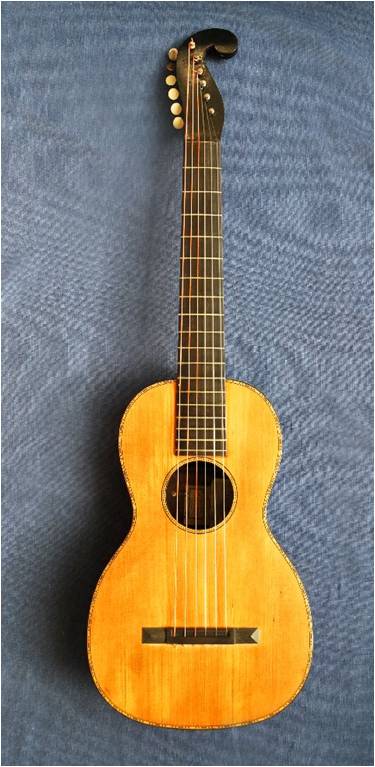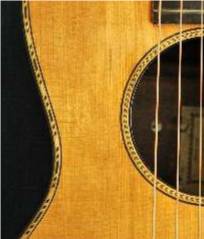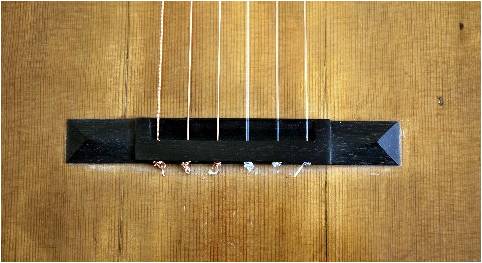This guitar was made in May 1839 and may well be the last guitar made by C. F. Martin Sr. in New York.
The guitar contains a type 5 Martin label AND a Ludecus & Wolter label. Martin used the type 5 label in two periods, from April 1837 to April 1838 and again from September 1838 to May 1839, after the short-lived Martin & Bruno pertnership ended.
The labels from the two periods are easily differentiated. The labels from the first period always have "& 196 Hudson Str" hand written on the label, when Martin had two locations, while the labels from the second period do not. All type 5 labels have a serial number written on the bottom margin. The labels from the first period have uniformly lower serial numbers than from the second period.
Martin sold his store inventory to Ludecus & Wolter on May 31, 1839. As part of the sale Ludecus & Wolter also received the Martin sales "agency" for New York. Since this guitar has a Ludecus & Wolter label it must come from the very beginning of the agency. The Martin sales agency was so important that they advertised the fact in their entry in the 1839 edition of Longworth's American Almanac.
The guitar with serial number 1296 also exists and has a Martin & Schatz AND a Ludecus & Wolter label so was one of the first Martin guitars made in the Cherry Hill PA area. The guitar with serial number 1304 has a Martin & Schatz AND a Martin & Coupa label. Based on the serial number it can be seen that the Ludecus and Wolter agency was very unsuccessful and sold very few guitars, no more than ten guitars between May 1839 and February 1840, which resulted in Martin giving John Coupa the agency in March 1840.
The guitar no longer has the Stauffer shape Martin had used to this point and is in fact the earliest Martin guitar known with the Spanish shape. It is not the fully mature Spanish shape that characterized Martin guitars for the remainder of the 19th century but is a transitional Spanish shape that only appeared in 1839. The easiest way to see the difference is that the bottom of the guitar is more rounded than later guitars, which have a flatter-looking bottom.
The single sound hole ring on the inside of the sound hole is typical for 1830s Martin guitars and not at all like the three ring decoration began to use in 1840.
Martin was just transitioning from the use of shield-shaped bridges to pyramid bridges at this time. The pyramid bridges were all tie bridges until about 1843 but this one is unusual in that it has an ebony drop-in saddle. An ivory drop-in saddle is far more often seen.
Period features
Back and sides: Brazilian rosewood
Top: European spruce
The chapter on dendrochronology in "The Century that Shaped the Guitar" (Westbrook 2005) convincingly demonstrates the top wood of early Martin guitars is European spruce. The only conclusion that can be drawn is that C. F. Martin Sr. brought a supply of European spruce with him when he emigrated from Saxony. All pre-1840 Martin guitars have this type of top wood. Since Martin made approximately 400 guitars between 1834 and early 1840 this must have been the extent of his original supply.
"Fine" purfling, similar to that used on later style 27 Martin guitars
Rosewood binding
Ebonized headstock veneer
Ebonized neck
Brass Vienna machines or, as Martin often called them, one side screws. This type of one side screw differs from the type encountered on earlier Martins.
Dimensions
Total length: 37" (940 mm) Fingerboard width at nut: 1.93" (49 mm)
Body length: 17.24" (438 mm) Fingerboard width at 12th fret: 2.40" (61 mm)
Upper bout: 8.27" (210 mm) Diameter of sound hole: 3.31” (84 mm)
Lower bout: 11.22" (285 mm) Scale length: 24.5" (623 mm)
Depth at upper bout: 3.39" (86 mm) Depth at lower bout: 3.90" (99 mm)








One thought on “1839 Martin Guitar, Serial Number 1293”
This is “Eye Candy” for us guys that collect pre-Civil War Martins.